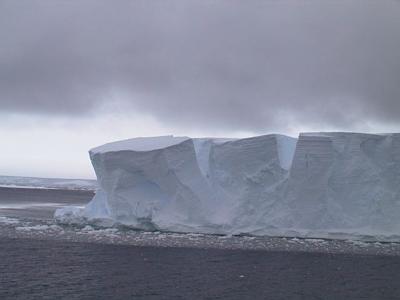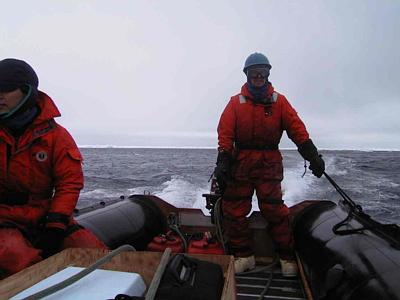14 March, 2000
Bits and Pieces, and a True Confession
73 00 s, 107 38 w
Temp -0.6 C, wind northeast at 25 knots (29 mph)
Barometer 978 mb, falling slowly
Light snow, no stars
Depth 475m (1558 ft)
Ship on CTD station, 75% open pack, one meter swell.
Here are some bits and pieces of what is going on aboard the
Nathaniel B. Palmer. They don't form a coherent whole, but here's my
excuse: In the past, when I have read accounts of people in Antarctica,
sometimes it was the odd little detail that fascinated me. Here are some
odd little details.
About twenty-four hours ago we left the shelf break, where the
relatively shallow (475 m) continental shelf drops steeply to oceanic
depths of 2000 m or more. We were following the break eastward for two
reasons. First, we wanted to map it. Before now, nobody knew within tens of
kilometers where the break was. It is important to know its position to
know the extent of the ice cap at its maximum about 15000 years ago. The
second reason we were out by the shelf break was more practical. There is a
large area of dense pack ice we've been forced to go around. The ice
extends from about 107 45w to 113 00w, and from 71 40s to 72 50s. It
probably would have been possible for the Nathaniel B. Palmer to go through
that area, but progress would have been very slow. With the need to back
and ram, we might only have made five or six kilometers per day.
We have now come south 220 km (136 miles) from the shelf break,
along 107w longitude, trying to work to the west as much as we can along
the dense pack ice edge. The bathymetry (bottom contour) of this part of
the Amundsen Sea is virtually unknown, although the area to the east of us
has been sparsely mapped. Remember that the Antarctic continental shelf is
deeper and more sculptured near the land, because the glaciers have eroded
more there. We are now getting far enough south so that the featureless
flat outer shelf bottom is starting to show contours. We know from previous
voyages that near the edge of Thwaites and Pine Island Glaciers the water
is deep (1000m) and the bottom is uneven bedrock scraped clean by numerous
glaciers. We are just getting down into that area now. It is exciting to
watch the SeaBeam image of the bottom as we explore new territory.
Our navigation is somewhat hampered by the lack of satellite
visual images of the ice. The most recent picture we have is almost a week
old. The Amundsen Sea area has been covered with clouds for that long. We
have microwave images but they are hard to interpret.
The north wind and near freezing temperatures of the last week
have brought with them gray overcast and almost continuous snow. A low
pressure centered on the ice cap to the southwest of us seems to be the
cause of this weather and the reason clouds have obscured visual satellite
images. It is strange for me, a northern hemisphere weather watcher, to
think of a warm north wind. In Maine, north winds mean clear cool air.
Southerly winds produce that effect here.
Night and day, the temperature for the last few days has been just
below freezing, within a degree or so, and remarkably constant. It requires
a lot more energy to melt ice and raise the temperature a degree from -0.5
C to +0.5 C than to raise the temperature from say -3 c to -2 C. The
relatively warm north wind loses its heat over the pack ice, which absorbs
heat like sand absorbs water.
The change in the day length here is remarkable. I arrived at
McMurdo station just about one month ago. At that time the sun was above
the horizon twenty-four hours a day, and would not dip below until February
18. A week from now will be the equinox, when worldwide there will be
twelve hours of light and twelve hours of darkness.
If you do the math, that means that the day length will have gone
from twenty four to twelve hours in about 45 days, thus the average loss is
about one quarter hour per day. Remember, though that the rate of light
loss is greatest around the equinox and least near the solstices. I haven't
figured it exactly, but my guess is that during the week surrounding the
equinox, we will be losing one half hour of light per day at this high
southern latitude.
The rapid loss of daylight, together with the midnight to noon
watch I am on, has played havoc with my sleep schedule. Another
contributing factor is the frequent clock changes because we cross through
longitudes and time zones so frequently. For the last week or so my sleep
has been divided into two periods, from about noon to three, and from about
eight in the evening to eleven. I'm not sure how it ended up this way, but
I don't think it is healthy in the long run. As I write this, I've set the
type size to 18 point on the computer, because I'm having trouble reading
finer print. Part of that is long periods staring at seals through
binoculars, and part is lack of sleep (and part is age!)
I think another reason I don't get enough sleep is that I want to
get the most out of my experience here. There's always something
interesting going on, people doing ice observations, seal sampling, and new
bathymetry. I don't want to miss any of it.
Here's the confession: I've never been a mad fan of marine
mammals. I know it's a horrible thing to say, but until recently, whales
and seals with their big warm eyes and highly developed brains were things
that were there, but not on my radar screen. I'm changing now.
Whales got on the radar screen first. I spent some time on fishing
boats off the Maine coast and saw humpback whales up close. They were the
real things, flesh and blood, rolling in the water and breathing out in
long deep sighs I could hear and smell (a not unpleasant, musty, fishy
odor). A couple of encounters were enough to get me hooked.
Now I'm getting fascinated with seals. During the first part of
our voyage, we didn't see many, and the ones we spotted were at quite a
distance (the exceptions being the ones I saw hauled out at McMurdo
Station.) During the last week we have seen large numbers of marine mammals
and penguins, and I've spent whatever spare time I have watching them.
There are only four kinds of seals here, and Ross Seals are so rare that
they hardly count (I haven't seen one yet). This means that I'm down to
three choices when attempting identification: Leopard, Crabeater, or
Weddell. They are big animals, and stay put, unlike little birds that will
fly around and hide every time you try to identify them. Yet with these
advantages, I'm still having a hard time telling one seal from another,
even up close. I'm getting better though.
Two days ago the seal people had a record day for sightings in a 7,5 hour
shift. They saw and recorded:
977 seals of all types
22 Minke whales
4 Fin whales
1 Orca or killer whale
167 Adelie penguins, and
4 Emperor penguins
They said there were more seals and whales, but they were recording as fast
as they could write. Yesterday they sampled two Leopard seals, including
one old bull that was the largest they had ever seen.
As the sun set this evening I went up in the ice tower, thinking that I
might do some more seal watching, and, knowing that nobody was up there,
glad to have the chance to be alone.
Of course there were no seals to be watched; they were all swimming and
feeding underwater. Mid afternoon is the time to see them hauled out and
resting. I'd been told that, but it did not sink in until I came up and saw
the empty floes. The only living things were a few Adelies. Looking around,
I saw the same endless landscape of mixed pack ice, and off in the distance
a few isolated bergs. I knew that under all the ice swam seals, whales,
penguins and krill in large numbers, yet the world I saw was lifeless.
Animals live and die here in this vast gray waste, and for them it's
probably a familiar neighborhood. From my point of view, though, it is a
vacant, cold, wild, and spooky place.

An iceberg ready to calve. It's not falling yet, but it can't be long.

Breaking pack ice at night.

A morning Zodiac delivery. The seal people have been left off on a nearby floe in search of Crabeaters. Shusun Li (left) gets a ride to some gray ice to take some reflectivity data as the satellite passes overhead. Steve Ager, Nathaniel B. Palmer mechanical technician steers the Zodiac.I'm shivering in the bow behind the camera.
Contact the TEA in the field at
.
If you cannot connect through your browser, copy the
TEA's e-mail address in the "To:" line of
your favorite e-mail package.
|
